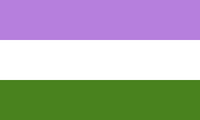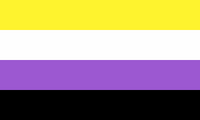No edit summary Tags: Visual edit Mobile edit Mobile web edit |
(Reworded intersex section and put a brief description of what intersex is as done in the transgender article.) Tag: Visual edit |
||
| Line 48: | Line 48: | ||
====Intersex==== |
====Intersex==== |
||
{{Main|Intersex}} |
{{Main|Intersex}} |
||
| + | Intersex is an umbrella term for various people who are born with or develop sex characteristics that differ from binary notions of a "male" or "female" body. These differences are called variations, and may involve one's hormones, chromosomes, external and internal reproductive organs, or secondary sex characteristics. |
||
| − | While intersex people have anatomical or genetical traits that differ from the typical binary notions of male or female body,<ref name="interact">{{Cite_web|url=https://interactadvocates.org/faq/|title=FAQ: What is intersex?|author=interACT|work=[https://interactadvocates.org/faq/ interACT] |date=2018-09-18}}</ref> their gender identity does not necessarily fall outside the binary, whereas it is the opposite with non-binary people: they are typically born with a body within the binary concept of male or female, but their gender identity is something outside of that concept.<ref name="NCTE" /> |
||
| + | |||
| + | Being intersex and being nonbinary both involve falling outside the notions held within the binary. However, this is in different ways. Being intersex mainly relates to one's sex characteristics,<ref name="interact">{{Cite_web|url=https://interactadvocates.org/faq/|title=FAQ: What is intersex?|author=interACT|work=[https://interactadvocates.org/faq/ interACT] |date=2018-09-18}}</ref> whereas being nonbinary mainly relates to one's gender. As such, intersex people are not inherently nonbinary (and vice versa), and be intersex and nonbinary at the same time. <ref name="NCTE" /> |
||
====Transgender==== |
====Transgender==== |
||
Revision as of 21:35, 23 January 2022
Non-binary is a term referring to individuals whose gender identity does not exclusively fall into the binary gender classification of only "man" or "woman." Those who identify as non-binary may identify with either masculinity or femininity in some capacity, both, or neither at all.[2] Although it is a gender identity on its own, it can also be used as an umbrella term to refer to many gender identities.[3] While non-binary is included in the transgender umbrella, not all non-binary people identify as such.[4]
Since identifying as non-binary can mean different things to different people, it is best to ask someone who uses the term what it means to them.[3]
Etymology
The name non-binary is a combination of the prefix non- (meaning "not, the lack of") and binary (meaning "consisting of two"), literally meaning "not consisting of two" and properly used as an adjective.[5]
The alternative name "enby" comes from the pronunciation of the abbreviation "NB". The best practice is to abbreviate non-binary as NBi rather than NB, as NB is sometimes used to mean "non-Black" when referring to non-Black people of color (POC).[1]
Community
International Non-Binary People's Day is observed each year on July 14, with the first time having been in 2012. The date was deliberately chosen for being precisely in between the International Women's Day (March 8) and International Men's Day (September 18), thus being reflective of the gender identity that is outside the binary.[6] The week surrounding July 14 is known as the Non-Binary Awareness Week, which is a specific time by, for, and about non-binary people to celebrate themselves and the communities, and to spread awareness to other people to how they can be a better ally to non-binary people.[7]
History
| Expansion needed | |
| This section is incomplete. You can help LGBTQIA+ Wiki by expanding it. |
Document the community's most important history, including facts such as key events, breakthroughs in improving the community's wellbeing and rights, or historical figures known to belong to the community.
Flag

Marilyn Roxie's genderqueer flag from 2011 was intended to represent all genderqueer and non-binary people.
In 2011, Marilyn Roxie designed a flag to give more visibility to all non-binary and genderqueer people consisting of three horizontal stripes, from top to bottom, of lavender (representing those relating someway to the gender binary), white (gender neutrality), and green (representing those outside of the gender binary). However, as the genderqueer community grew, the design became more representative of them specifically, and the feeling that it was not directly applicable to non-binary people anymore grew. The call to have their own representative flag was answered in 2014 by Kye Rowan, who designed the current non-binary flag to fly beside the genderqueer one rather than replace it.[8][9]

Kye Rowan created the non-binary flag to compliment the genderqueer one.
The non-binary flag consists of 4 horizontal stripes: The yellow at the top represents those whose gender exists outside the gender binary, while the purple indicates those who do relate to it, having genders that fall somewhere between "man" and "woman" or are considered a mix of them.[10] The white represents those who are multigender, with many or all genders, and the black refers to those who are agender, without a gender.[11]
Distinction
Since non-binary is also considered to be an umbrella term, there are multiple terms that are associated with it. While there is a certain overlap between them all, the common denominator often being "having a gender experience outside the binary," there are nuanced differences to each of them.[12] However, despite there being definitions for each of them, their meaning can vary depending on culture or even geographic regions.[3]
Genderqueer
- Main article: Genderqueer
Non-binary generally is used as the catchall term for those who do not identify with the gender binary, whereas genderqueer often refers more to a particular experience under that umbrella, referring to non-normative or queer gender.[13] The two terms are closely related and often used interchangeably, but that does not make them synonyms, and thus one should always defer to a person's preferred identifier.[3][14]
Intersex
- Main article: Intersex
Intersex is an umbrella term for various people who are born with or develop sex characteristics that differ from binary notions of a "male" or "female" body. These differences are called variations, and may involve one's hormones, chromosomes, external and internal reproductive organs, or secondary sex characteristics.
Being intersex and being nonbinary both involve falling outside the notions held within the binary. However, this is in different ways. Being intersex mainly relates to one's sex characteristics,[15] whereas being nonbinary mainly relates to one's gender. As such, intersex people are not inherently nonbinary (and vice versa), and be intersex and nonbinary at the same time. [12]
Transgender
- Main article: Transgender
Non-binary identities are included under the transgender umbrella term as they are people whose gender differs from what they were assigned at birth. However, the two identities are distinct, and people can identify as both trans and non-binary. A binary transgender person differs from their birth assignment by identifying as a man or a woman rather than female or male. A non-binary person may never identify with either binary term, or they may partially identify with either or both terms, which can include their birth assignment. A trans non-binary person is thus someone who both does not identify with their birth assignment (trans) and has a gender identity that is neither exclusively man nor woman (non-binary). Not all non-binary people identify as trans and not all trans people identify as non-binary.[16]
Demigender
- Main article: Demigender
Part of the non-binary spectrum, demigender is an umbrella term of its own accord referring more specifically to people who feel a partial connection to a certain gender, such as demigirl, demiboy, or demifluid.[3]
Controversy
| Expansion needed | |
| This section is incomplete. You can help LGBTQIA+ Wiki by expanding it. |
If there has been a specific variety of this identity-phobic discourse that has led to discrediting it please detail that here. If there have been similar -phobic discourses around popular flags, it can also be documented in this section.
Perceptions and Discrimination
Non-binary erasure
Erasure in the context of gender refers to the practice of erasing, ignoring, or antagonizing of people whose genders are outside of the gender binary.[17] For non-binary people, this often refers to them being overlooked in legal matters, such as having to indicate a binary gender on passports and driver's licenses, and the use of gendered language. The extent of this differs from language to language, as some are better suited for gender-neutrality. Where identifying as non-binary is an internal process of acceptance, people are constantly forced to reaffirm their identity by that erasure in a binary society. This can make folks very uncomfortable.[18] While this constant challenging of their identity may not seem that noticeable by those who are not non-binary, being on the receiving end of continuous erasure and perception of not being accepted may lead to depression, anxiety, and other mental issues. In a binary society, the extents of this are noticeable in every aspect of life, from linguistics to even buying clothes, using the bathroom, going to school, meeting new people, or receiving medical care.[17]
Misgendering
- Main article: Pronouns § Misgendering
Misgendering is the act of attributing the wrong gender to a person, whether it be deliberate or not. While non-binary people identify outside the gender binary, they often prefer gender-neutral pronouns, though this too is a personal decision and some non-binary individuals still use binary pronouns. To avoid assuming, one should always ask which pronouns someone prefers and when in doubt, opt for gender-neutral language.[19] Since not all language, especially not English, is suitable for gender neutrality, language has to evolve. On September 17, 2019, the Merriam-Webster dictionary update its definition of the word "they" and included that it could be used as a way to refer to individuals in a neutral way.[20]
Media
Literature
Film
Television
- Adira Tal from Star Trek: Discovery
- Double Trouble from She-Ra and the Princesses of Power
- Kai Bartley from the eighteenth season of Grey's Anatomy, portrayed by non-binary performer E.R. Fightmaster
- Mae Martin from Feel Good
- Stevonnie from Steven Universe
- Syd from One Day at a Time
- Taylor Mason from Billions - the first non-binary main character in a major television series in North American TV history.[21]
- Theo Putnam from Chilling Adventures of Sabrina - watch What I Wish You Knew: About Being Nonbinary on YouTube, where non-binary actor Lachlan Watson is joined by other non-binary performers Liv Hewson, Jacob Tobia, and Shiva Raichandani and discuss and dismantle misconceptions about being nonbinary.
Music
- Demi Lovato
- Sam Smith
- Utada Hikaru
Public figures
- Amandla Stenberg
- Asia Kate Dillon
- Bex Taylor-Klaus
- Daniela Sea
- Emma Corrin
- E.R. Fightmaster
- Gigi Goode
- Indya Moore
- Joan Stokes
- Joey Soloway
- Jonathan Van Ness
- Lachlan Watson
Resources
- Trans Lifeline — Peer support by trans people, for trans people (US and Canada)
- National Center for Transgender Equality — Know Your Rights guides to legal rights in various situations, other self-help guides, information about various topics
